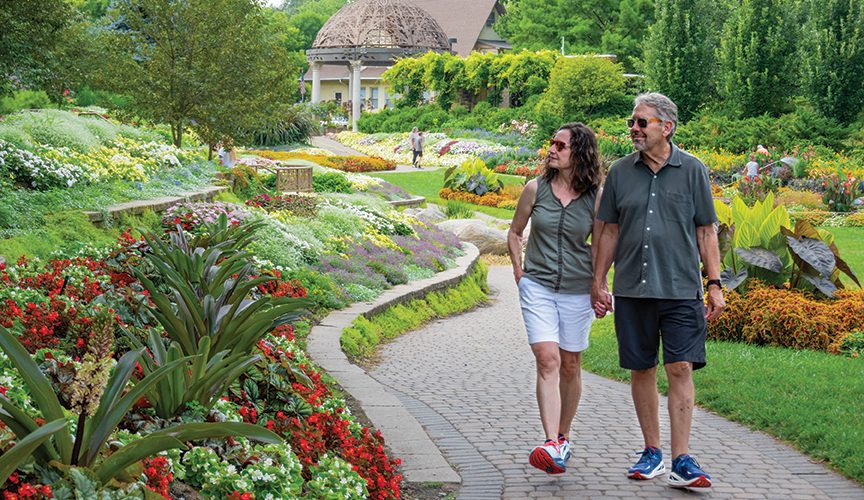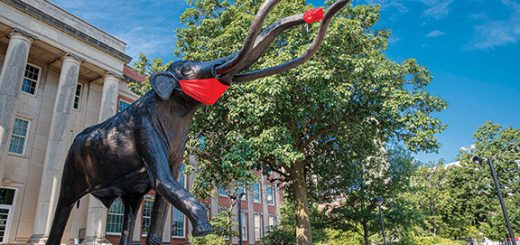Lincoln’s Lush Gardens

by Patty Beutler
At the busy intersection of 27th Street and Capitol Parkway nestles a treasure of a garden that transports one away from the traffic to a place of tranquility.
A visit to Lincoln’s Sunken Gardens promises a meandering pace along bricked pathways rimmed with bursting colors and intricate displays of flowers in shades of pink, purple, orange, yellow, blue and white of various sizes and fragrance. You are surrounded by beauty on all sides in this 1.5 acre wonderland. You’ll gawk at the giant elephant leaves and glory in the greenery everywhere. All this for free.
This combination of trees, shrubs, perennials and thousands of annuals dazzles the eye. You’ll find coleus, zinnia, canna, impatiens, begonia, marigold, hibiscus, salvia, millet, hydrangea and even Peruvian daffodil in multicolored array, to name just a few. Some 30,000 annuals join perennials from hostas to viburnum.
No wonder the Sunken Gardens is Nebraska’s only garden listed in the 300 Best Gardens to Visit in the United States and Canada in National Geographic’s Guide to Public Gardens. That should be impetus enough to seek it out. And since the gardens are redesigned each year with a different theme, you can visit many times over and never see the exact same thing.
Alice Reed, senior gardener with Lincoln Parks and Recreation, has helped design the gardens for 38 years. She’s watched hundreds of thousands of people stop by every summer, including walk-ins and busloads of visitors. “We greet and meet people from all over the world every day, so I think we’re sort of like ambassadors for Lincoln,” she said.
Floral schemes in past years include A Wonderland, Ruby Slippers, Van Gogh’s Starry Night, Moon River and Purple Haze. Imaginations required, said Reed.
But it wasn’t always that way. What used to be a neighborhood dumping ground began to take shape in 1930 thanks to some donated land and the work ethic of 200 unemployed men hired by the city during the Depression years. The original garden area included two reflecting ponds, which exist today, populated by colorful koi fish that swim happily in the pools, hoping that visitors ignore the “don’t feed the fish” signs. Water lilies and lotus float on the surface, giving the living pools a tropical feel.
But there’s more. The terraced plantings brim with color, and steps leading upward open to a quiet green space on one side and a small-scale, natural-looking waterfall on the other. Once past the cascading feature—stop to listen to the soothing sound of the trickling water and admire Flora and Fauna, the two stone frogs at the base—visitors will find at the top a statue titled Rebekkah at the Well, a replica of the original 1936 piece that weathered with time. Follow the winding path to a space called the Healing Garden, filled with white blossoms, fashioned after a famous garden at Sissinghurst Castle in Kent, England, in the 1930s. Here is a place of respite, calm and reflection. Benches invite the visitor to pause for a moment of peace and quiet in this welcoming place. If you arrive with worries or lingering grief, revel in the healing power of this natural sanctuary.
On the other side of the garden is a lacy, laser-cut gazebo installed during the 2005 renovation that depicts each of the seasons, a piece of artistry in itself. Nearby on this pavilion are restrooms that are open April through October 9 a.m. to 8 p.m. Long after the blossoms have died and many of the plants go dormant, the garden comes alive again in the cold weather with wreaths and holiday lights at night on ornamental trees.
Handicap accessible and popular for portraits, weddings and celebratory occasions, the Sunken Gardens is indeed a community treasure. Folks show their appreciation by volunteering their labor alongside staff for two big events a year—Wake Up the Beds in the spring and Put the Beds to Bed in the fall.
“Everybody wants to take part,” said Reed, who noted the popularity of planting. “It builds a little ownership; they love to come down and see what we’ve designed for them to install, so that’s fun.”
Volunteers also join in for Garden Gab every Tuesday and Thursday at 9 a.m. at the pavilion to learn a garden lesson and then to help with weeding and bug disposal or whatever needs doing, Reed said, grateful for the help.
This lush retreat beckons, a respite from the nearby urban hubbub. Go explore.
Other public gardens to enjoy around town:
Hamann Rose Garden, 27th Street and C Street
This formal garden features 2,700 individual roses and more than 100 or so varieties. A gazebo, sculptural pieces and fountain grace the garden, which is free and open from 5 a.m. to 11 p.m. It is available to reserve for special occasions. Renovated in 2008, the landscape features two gardens, a formal display of cutting roses and an informal strolling garden of hardy landscape roses.
Rotary Strolling Garden, contiguous to the Rose Garden on 27th Street
Perennials, grasses and shrubs dominate this 3-acre garden that highlights sculptures, a gazebo and paved labyrinth plus plenty of hydrangea plantings. The garden aims to please the elderly and the physically handicapped, but welcomes people of all ages. Purple asters to yellow yarrow ring the circular garden in bright color.
Maxwell Arboretum, on the UNL East Campus, 37th Street and Holdrege Street
Trees take center stage on this five-acre plot of land. Oaks, maples, pines, evergreens and deciduous giants fill this forest-like area. Enjoy the towering trunks and leafy green canopies for a walk through the shade. Dedicated as the second site of the Nebraska Statewide Arboretum, the area features trees and shrubs that provide the greatest diversity of plant species on the campuses.
Veterans Memorial Garden, in Antelope Park, east of the Auld Pavilion, 3200 Memorial Drive
This walk-about garden features a number of tributes, memorials and monuments to the many women and men of Nebraska who served in the branches of the armed forces defending this country. Benches are scattered about to offer some quiet reflection on those who have served in the past and those who are doing so currently. It’s a place of contemplation and gratitude.














Recent Comments